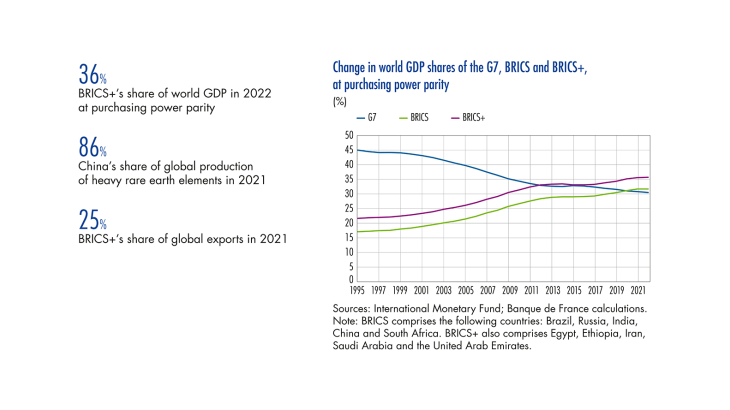1. From BRICS to BRICS+: an expansion that strengthens cooperation within the group and increases its socioeconomic weight
BRICS expansion – a new stage in the assertion of BRICS’s position at the centre of the world agenda
The expansion of BRICS on 1 January 2024 to include five new countries marks a new stage in the bloc’s emergence as an economic and political force. After starting out as an economic and financial acronym (O’Neill, 2001), BRICS (Brazil, Russia, India, China and South Africa) has gradually evolved into a more formal political grouping. Since 2009, its four founding members, which were subsequently joined in 2011 by South Africa, have met formally at Summits of Heads of State and Government. At the 15th Summit in Johannesburg (22-24 August 2023), the group reached a new milestone by inviting six further emerging and developing countries (Argentina, Egypt, Ethiopia, Iran, Saudi Arabia and the United Arab Emirates) to join, with effect from 1 January 2024 (see map), although Argentina subsequently declined following Javier Milei’s victory in the December 2023 presidential elections. With the expansion, the new “BRICS+” has increased its global economic and political weight and, according to the Johannesburg Declaration (15th BRICS Summit, 2023), will promote collaboration, solidarity and strategic partnerships in the “Global South” in a spirit of commitment to inclusive multilateralism.
The enlargement gives BRICS+ greater economic and demographic weight
BRICS+ carries significant demographic and economic weight, accounting for nearly half the world’s population (46%, up from 41% for BRICS) compared with just under 10% for the Group of Seven (G7): United States, Canada, Japan, United Kingdom, Germany, France and Italy. BRICS already accounted for a larger share of world GDP than the G7 (31.6% at purchasing power parity (PPP) in 2022; see Chart 1), and the expansion has increased this share to over a third (35.6% in 2022). China still holds the dominant position within the group, however, accounting for 52% of its total GDP (at PPP), which is similar to the United States’ weight within the G7. The gap between BRICS+ and the G7 is set to widen further thanks to robust economic growth in emerging countries: according to forecasts by the International Monetary Fund (IMF), BRICS+ will account for 37.6% of world GDP at PPP in 2027, compared with 28.2% for the G7.
[To read more, please download the article]
